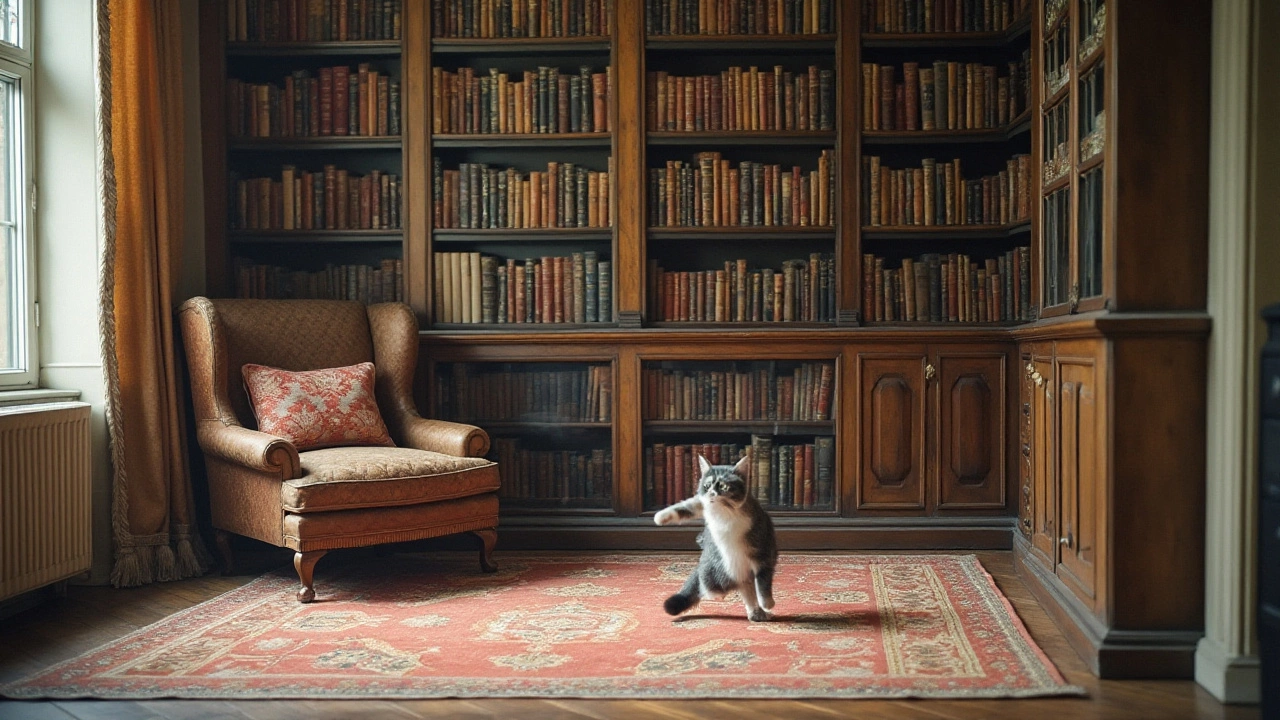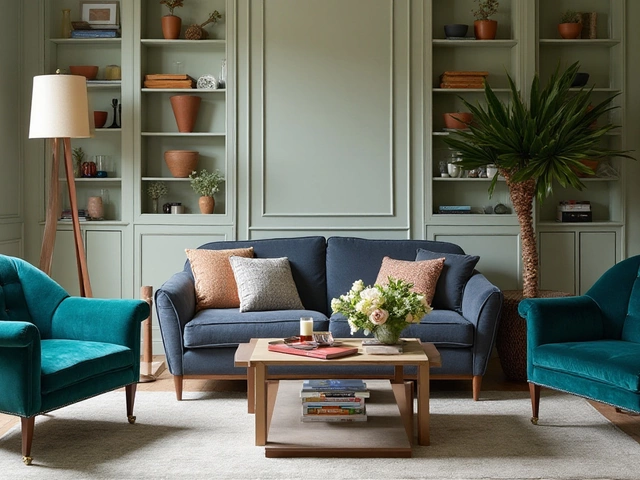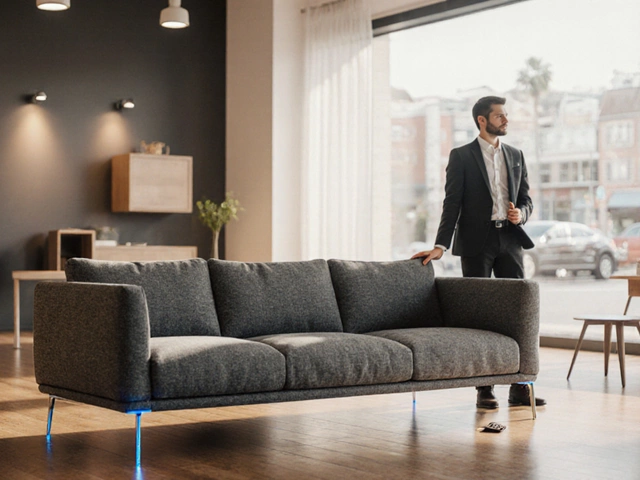 11
Dec,2024
11
Dec,2024
Picture this: a tall bookcase filled to the brim with your cherished tomes, framed photos, and perhaps a few decorative trinkets. It stands proud, a beacon of your reading adventures and personal style. But have you ever considered the safety implications of leaving it unsecured? The truth is, anchoring your bookcases can make the difference between a charming fixture and a hazard waiting to happen.
Many people overlook the need to fasten their bookcases to the wall, often thinking only about aesthetics or ease of rearrangement. Yet, this simple act of precaution can prevent accidents, especially in households that welcome children and pets. In this read, we'll explore why anchoring bookcases is not just a good idea but a necessary measure for ensuring safety and stability in your home.
- Understanding the Importance of Anchoring
- Potential Risks of Unanchored Bookcases
- Steps to Properly Anchor Your Bookcase
- Alternative Solutions for Bookcase Stability
- Tips for Maintaining Organized and Safe Bookcases
Understanding the Importance of Anchoring
When we think of securing our homes, minds rarely leap to bookcases. Large, stately, and often chock-full, these pieces of furniture can become unwitting hazards without proper attention. The necessity of anchoring stems from both physics and practicality. A loaded bookcase has a high center of gravity, and without anchoring, even a slight nudge or a playful bump from a child's game can compromise its stability. A New York Times report indicated that between 2000 and 2020, furniture tip-overs were responsible for thousands of emergency room visits each year. Such alarming statistics underscore the risks involved with ignoring this simple safety measure.
Consider the scenario of a vibrant, bustling household filled with children. Little hands are often curious and adventurous, resulting in climbing explorations that could easily cause a top-heavy bookcase to topple. Beyond the potential for physical harm, there is also a significant emotional toll at stake when accidents occur. The Consumer Product Safety Commission (CPSC) strongly advises anchoring bookcases and other large furniture items to secure them safely in place.
"Anchoring our homes is vital in protecting our loved ones," a CPSC spokesperson once remarked, emphasizing the ongoing campaign to increase awareness about household hazards.
Anchoring is not merely an aesthetic choice; it's an initiative in promoting a secure living environment. It’s essential too for those residing in earthquake-prone regions where tremors can discretely shift a room's contents, turning mundane furniture into potential dangers. By affixing the piece to the wall, anchoring becomes a preemptive action against natural disturbances. In regions where seismic activity is frequent, anchors serve as crucial safeguards against unexpected shifts that could lead to catastrophic outcomes. Moreover, in high-rise buildings, where even slight movements of the structure could have implications, anchoring plays a heroic, albeit quiet role.
The practicalities of implementation are straightforward and accessible. Commercially available kits provide all necessary components, including wall brackets, straps, and detailed instructions. Many bookcases now come with pre-drilled holes or provisions for easy anchoring, acknowledging the importance of this step. For those who find themselves less than handy, hiring professional help to ensure correct installation can provide peace of mind, knowing that an expert has secured the safety of one's environment. The task, though seemingly minor, yields invaluable dividends, transforming potential hazards into steadfast allies in home safety.
For libraries and public spaces, the importance is magnified. These environments see a higher foot traffic volume, and the responsibility to protect patrons falls on administrators. By setting an industry standard that prioritizes the well-being of users, venues that anchor their furnishings echo a commitment to societal safety norms. Organizations such as the American Library Association have highlighted protocols to follow, ensuring that their spaces not only promote knowledge but also safeguard it beneath beams of stability.
Anchoring can often be perceived as an inconvenience or an unnecessary step, yet its importance in home and public areas is undeniable. Whether motivated by protecting inquisitive children or reducing earthquake risks, the initiative stands as a guardian of safe living. Consider the simple process of securing a bookcase not as an aesthetic disruption but as a cornerstone of responsible home management, one that prioritizes health and well-being over superficial arrangements. It's a modest tweak that delivers robust results in securing the environments we call home.
Potential Risks of Unanchored Bookcases
A towering bookcase might seem innocent enough, just standing there brimming with novels and family photos, but looks can be deceiving. The reality is that without being securely fastened to the wall, a bookcase can become a potential hazard in your home. There's a hidden but very real danger that many overlook—the risk of these tall structures toppling. Such incidents can occur during unexpected events like earthquakes, even minor tremors, or simply from the weight imbalance caused when it is unevenly loaded with books and items.
One of the gravest concerns with unanchored bookcases is the risk they pose to children and pets. Toddlers are naturally curious and often see bookshelves as tempting jungle gyms. Their innocent attempts to explore can lead to the entire structure crashing down if it's not anchored securely. Similarly, your curious pet might get a little too adventurous, jumping or bumping against the unit, triggering a dangerous domino effect. Falling bookcases can cause serious injuries, ranging from bruises to broken bones or worse, putting those within the vicinity at significant risk.
Moreover, there is the potential for extensive damage to both the bookcase and your belongings. In homes with heavy foot traffic or vibration-heavy areas, unanchored units can gradually become unsteady, leading to gradual shifting until a disaster occurs. This doesn't just threaten physical items like books or gadgets but can also damage the flooring or walls during a fall, leading to costly home repairs. Given the value of books and personal mementos, such a fall is as financially damaging as it is physically risky.
"Anchor furniture if a child lives in or visits your home,” the U.S. Consumer Product Safety Commission advises. Their campaign, 'Anchor It!', highlights the importance of securing furniture to prevent injuries and fatalities. Their studies indicate that a child is sent to the emergency room every 46 minutes due to furniture tip-overs."
Considering the Unseen
It's not just about life-threatening situations either. The day-to-day movements around an unstable bookcase can disturb your peace of mind. There's often an unrecognized stress associated with such worry, thinking about what might happen if you accidentally knock into the unit while vacuuming or reaching for a high shelf. It could be a heartstopping moment watching a bookcase wobble precariously. Securely anchored bookcases mean fewer worries about these what-ifs, and more peace in your living space.
In public spaces like schools and libraries, the anchoring of bookshelves is often mandated by safety regulations. These institutions recognize the high risk such furniture poses in crowded environments, serving as a sober reminder of risks that are just as real at home. Learning from these examples and applying similar safety precautions in private residences can prevent significant trauma and property damage, reinforcing how essential anchoring is for every environment.
With just a little effort and foresight, the issue of unanchored bookcases and their inherent risks can be easily mitigated. It's a simple yet profound way to protect your loved ones and possessions. Understanding these risks clarifies why anchoring is not just about aesthetics or neatness—it's a necessary step in safeguard planning to secure a living area, making the home a truly safe space.

Steps to Properly Anchor Your Bookcase
Anchoring a bookcase is a simple yet vital task in maintaining a safe living space. The first step in this process is selecting the right location. Assess where you want your bookcase, taking into account the weight it will hold and the traffic around it. Ideally, it should be against a sturdy wall where it won't obstruct any pathways. Once you've picked the perfect spot, gather the necessary tools: a stud finder, drill, screws, wall anchors, L-brackets, and a level. This preparation ensures you have everything needed before beginning the work, saving you time and hassle.
With your tools ready, locate the studs in your wall using the stud finder. Anchoring into studs provides the best support as they form the skeleton of the wall. If you're not new to home improvement projects, you might appreciate the importance of a good stud finder. It's said to be the handyman’s best friend. Once located, mark their positions with a pencil. Should your chosen wall not have studs where you need them, consider using heavy-duty wall anchors that can support the weight. Remember, safety is the priority, so if in doubt, seek professional advice before proceeding.
Positioning the Bookcase
Position the bottom of the bookcase close to the wall and use your level to ensure it stands straight both horizontally and vertically. This step is crucial for installing your bookcase evenly, preventing unnecessary stress on the fasteners over time. Next, attach the L-brackets to the upper part of the bookcase. Typically, the top corners work best. Check that these are secure but loose enough to allow minor adjustments when attached to the wall. This is where precision makes all the difference. Have you ever noticed that the best DIY projects are those finished with both functionality and finesse?
If you have access to a smartphone, use one of the many free leveling apps available to further confirm your bookcase is perfectly aligned. A small detail indeed, yet it can make your arrangement appear professionally done, which is something any DIYer can be proud of. Now, mark the position on the wall where your L-brackets will be fixed. Drill into the studs or insert wall anchors if you are working with drywalls. Affix the L-brackets securely. This is when every second of patience and persistence pays off as the piece fits into place beautifully and safely.
"To secure furniture effectively, it's important to anchor into studs whenever possible, as this provides the strongest support," advises home improvement guru Bob Vila.
Finally, double-check the stability. Gently shake the bookcase to test its sturdiness. A properly anchored unit should not tip or sway. This is an excellent time to admire your handiwork and consider organizing and decorating. Whether it’s books, photos, or collectibles, you can now confidently adorn your shelves without fear of toppling and create a space that is as safe as it is aesthetically pleasing. Investing this effort not only protects your belongings but also ensures peace of mind in your home.
Alternative Solutions for Bookcase Stability
Sometimes, the thought of drilling into pristine walls to anchor a bookcase might make you wince. Perhaps you're renting your current abode or simply wish to avoid permanent alterations. Fortunately, there are several creative alternatives to traditional anchoring that can still keep your beloved bookcases steady. A popular option is utilizing furniture straps, which offer a less invasive way to secure heavier pieces. These straps are typically affixed to the back of the bookcase and the wall, preventing any unexpected tipping. They come in various materials, often including a flexible and sturdy plastic that holds firm under pressure, offering peace of mind without the requirement of drilling.
Another effective strategy is using L-brackets strategically placed at the bookcase's base or top. For those with heightened design consideration, seeking furniture-specific weight distribution solutions could involve advanced engineering, like using a weighted base integrated into the bookcase's lower structure. This can often offset the center of gravity, lending more balance without needing attachment. A thoughtful placement of heavy items on lower shelves can leverage the weight to ground the structure.
Weighted Solutions and Structural Adjustments
Opting for bookcases with wider bases inherently designed to resist tipping is yet another method. Such designs emphasize a low center of gravity, often utilizing broader legs or bases that naturally anchor the system. In modern furniture design, you may find options containing built-in anchors that do not require separate installation—a feature celebrated by aesthetic-conscious decorators and safety advocates alike. Considering the arrangement of books and other items can also play a role. Heavier books and items should be placed on lower shelves to help stabilize the bookcase.
For a more innovative touch, you might explore new products like “nano adhesive pads” which adhere to surfaces using millions of microscopic bristles. These are not sticky in the traditional sense but rather hold with an impressive strength by setting into the microscopic texture of surfaces. This method minimizes damage while still providing a surprising degree of strength and stability.
Jane Doe, a renowned home organization expert, once said, “Secure your shelves creatively, and safety becomes an integral part of your design rather than an afterthought.”Finally, rearranging your home's layout to naturally shield or support bookcases against sturdy walls or hefty furniture pieces can also diminish the likelihood of tipping.

Tips for Maintaining Organized and Safe Bookcases
Maintaining an organized and safe bookcase is crucial for the functionality and aesthetics of any room. A well-organized bookcase not only ensures easy access to all your bookcases items but also reduces the risk of accidents. To begin with, consider the weight distribution on each shelf. The heaviest books or decorations should be placed on the bottom shelf to provide a stable base that prevents tipping. As you move up the bookcases, lighter items can be positioned higher. This not only enhances balance but also makes the overall effect pleasing to the eye, guiding the viewer gently upwards.
Clutter can quickly become a problem if left unchecked. To manage this, regularly assess the contents of your bookcase and honestly decide whether each item deserves its spot. It can be wise to adopt the one-in-one-out rule, where a new addition means removing something old. This keeps the quantity of items in check. Arrange books by size or color for aesthetic cohesion, or organize by genre or author for functionality. Consider adding bookends to help keep sections neat, especially for smaller bookcases that lack side support. For parents and pet owners, it can be particularly important to use bookends as they prevent curious hands or paws from toppling stacks. According to The National Safety Council, over 25,000 emergency room visits each year in the U.S. are due to furniture tip-overs, highlighting the added necessity of such preventive measures.
Now, addressing safety, the anchoring process should be revisited every few months to ensure it remains effective. With time and use, restraints may loosen, threatening the stability of even a sturdy bookcases. When securing the bookcase to the wall, always follow the manufacturer's instructions to the letter to avoid any mishaps. Periodically inspect all the joined parts, such as screws or other fixtures, for wear and tear, which are common culprits in reducing the furniture's lifespan. If you lack the original anchoring kit, universal wall straps are a readily available alternative in most home goods stores, offering a simple yet effective solution.
Lighting can also play a significant role in maintaining both the utility and display potential of your bookcase. Well-lit bookcases are easier to navigate and significantly reduce the chances of accidents occurring due to poor visibility. Installing discreet LED strip lights can offer illumination without the need for lamp clutter. Alternatively, dimmable options allow you to adjust the mood based on the time of day or a specific event, making it a multi-dimensional tool for transforming room ambiance. In any case, make sure that cords or wires are managed neatly to prevent trips and snagging by running them along the back or sides of the bookcase.
"An organized bookcase is both a personal sanctuary and a reflection of one’s mind," suggests renowned interior designer Nate Berkus. Curating this space with intention elevates its impact, transforming it from mere storage to an integral part of your living environment. Simple additions like placing a soft rug in front can act as non-slip mats, ideal for households with little ones and pets. This combination of thoughtful arrangement and preventive strategies creates a safer atmosphere while highlighting the beauty of an often-underappreciated furniture piece in our homes.




